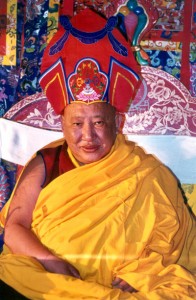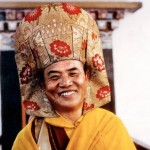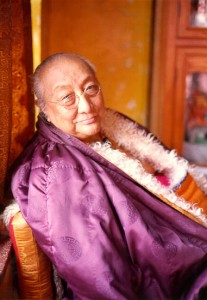His Holiness Taklung Tsetrul Rinpoche
Taklung Tsetrul Rinpoche was born in the central part of Tibet, near the famous lake called Yardrok where Guru Rinpoche left his handprint, in the Western year 1926. Close to his birthplace, in the region known as Taklung, was the prominent Taklung Tse monastic centre affiliated with Thubten Dorje Drak, the seat of the Northern Treasures (Chang Ter) Nyingma dharma tradition. In the 19th century, the great Khenpo Namkha Longyang from Dorje Drak recognized an ordinary monk from the monastery as the incarnation of Ngok Chöku Dorje. That tulku (Lobpön Kunzang Chöku) continued to study and train as an ordinary monk, and eventually became the vajracharya of the monastery. He devoted his whole life to practice and the attainment of superior realization. It is said that the special protector of Ngok, the glorious goddess Düsolma, pledged her service to him. His reincarnation (Tupten Chökyi Nyima) also moved up through the ranks of the ordinary monks to become the Acharya, but departed for the pure realms at a young age. The ninth Dordrak Rigdzin, Chöwang Nyamnyi Dorje, in accordance with a meditation vision, identified me as the next rebirth.
Rinpoche arrived at Taklung Tse Monastery and received his first ordination when he was five years old, as well as the title and enthronement of a tulku. When he was eight years old he was given a dharma seat at the mother monastery Thubten Dorje Drak.
He studied and became proficient in all of the monastic arts and rituals. From the age of fourteen he studied with a lama named Pawo Rinpoche, who was a student of Khenpo Thubten Gyaltsen, a personal student of the great Dzogchen Khenpo Shenga. When he was fifteen, the elder Khenpo from Gotsa Monastery, who was a personal disciple of the previous Dordrak Rigdzin, gave the empowerments and transmissions of the Jangter lineage to the current, great Dordrak Rigdzin, Namdrol Gyatso. At that time he received most of these empowerments and transmissions, as well as other Dzogchen instructions.
When he was twenty he received the complete empowerments and transmissions of the Rinchen Terdzö and others from the previous Shechen Rabjam Rinpoche. From the retreat master at Mindroling and from the previous Lalung Sungtrul Rinpoche, he received most empowerments and transmissions for the treasures of Padma Lingpa, and from Golok Chewo Rinpoche he received all the transmissions for the Seven Treasures and other teachings of the omniscient Longchen Rabjam.
At Dorje Drak he received all of the empowerments and transmissions for the higher and lower Jangter treasure teachings, as well as Kama (oral) teachings, and instructions on the nature of mind. He became the khenpo of Dodrak Monastery for several years, and then was requested to return to Taklung Monastery.
On the occasion of the 2500th anniversary of the Buddha’s parinirvana he went on pilgrimage to India with his family. Circumstances worsened from year to year in Tibet until it became impossible to remain there; and so, in 1959, Taklung Rinpoche and some companions ran away at night, leaving their homeland, until they reached India and then Sikkim, where he stayed for two years.
At Rumtek Monastery he received the empowerments and transmissions of the Treasury of Oral Instructions and Kagyu Mantra Treasury from the great 16th Holiness Gyalwa Karmapa. In Kalimpong he received the entire empowerments and transmissions of the Great Terma Treasury and the Nyingma Kama, as well as some of the dharma treasures of Dudjom Lingpa, from Kyabje Dudjom Rinpoche. In Bhutan, from Dilgo Khyentse Rinpoche he received transmissions for the collected teachings of Mipham Rinpoche, and empowerments and transmissions for the Heart Essence of Longchenpa, and other Dzogchen practices and tantras.
He later went to a new Tibetan refugee settlement in Simla, India, where in the years that followed he worked with the community, local and state government officials, and the office of His Holiness the Dalai Lama to found a new Dorje Drak Monastic seat in exile, to preserve, foster and expand the teachings of the Jangter lineage, since Thubten Dorje Drak Monastery in Tibet had been completely destroyed. Today there are almost 80 monks there, and several in retreat.
He has offered the Jangter, and other dharma empowerments and transmissions at the direction of prominent lamas of different lineages at various monasteries in Bhutan, India and Nepal, including Namkhai Nyingpo Rinpoche in Bhutan, Kyabje Penor Rinpoche in Mysore, and Dilgo Khyentse Rinpoche at Shechen Monastery in Nepal.



